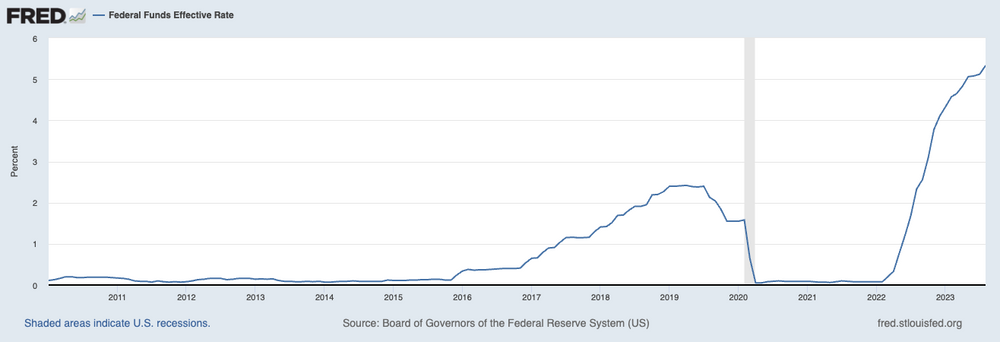They say military generals spend too much time preparing for the last war rather than the next one. I fear the same goes for real estate investors.
For the last 18 months, investors and pundits alike have hyperfocused on rising interest rates. Sure, commercial investors should buy interest rate caps, and all investors should find creative ways to borrow at low rates. But the time to protect against rising interest rates was two years ago—before they surged.
When I interview professional real estate investors and syndicators, I love to ask how they mitigate risk on their deals. I’ve particularly started asking, “What risks do you see in today’s real estate market—the ones no one’s talking about, but should be?”
I want to invest with people who understand not just what went wrong last time, but what’s likely to go wrong next time. Consider the following risks that too few investors are currently thinking about.
1. Interest Rates Staying High for Years
The consensus view among many economists and pundits for the last 18 months has been that we’ll likely have a sharp, but hopefully short, recession. Such a recession would reset the tight labor market, slash inflation, and prompt the Federal Reserve to cut interest rates back to the low levels we’ve all grown accustomed to in the 21st century.
That hasn’t happened. It still might, of course, but for now, the extremely tight labor market has kept inflation running strong. The current economy could continue well into 2024 and beyond, until something unexpected shakes it up.
The longer interest rates stay high, the greater the risk to commercial real estate markets. Many real estate syndications use short-term loans, such as three-year loan terms with available extensions. When their current loans and interest rate caps expire, these syndications could find themselves with crushed cash flow upon refinancing. The general partner could sell instead of refinancing.
But prolonged high interest rates also mean higher exit cap rates.
2. Expanding Cap Rates
High cap rates are great for buyers, who buy properties with greater annual income for the same purchase price. But they mean slimmer profits for sellers—if any at all.
Commercial cap rates rose from a narrow 4.13% in the first quarter of 2022 to just under 5% this year, ending the second quarter at 4.94%. That’s less than the federal funds rate, currently 5.25% to 5.50%, and which has shot up from just over 0%.

In other words, cap rates haven’t risen nearly as fast as interest rates. This makes sense, if everyone assumes interest rates will fall back down in 2024. But again, what if they don’t?
If interest rates stay high for years, they’ll eventually force cap rates up too. Read: much lower profits and returns for sellers, who underwrote their deals assuming a low exit cap rate.
It would leave sellers caught between an unprofitable sale and an expensive refinance, perhaps with little to no cash flow.
3. Spiking Insurance Costs
I’ve started hearing horror stories about insurance premiums jumping 40% to 125% in a single year.
Insurance companies have paid out billions over the last few years in the wake of natural disasters, from wildfires to hurricanes and beyond—billions more than usual, that is. And they’ve started hiking policy premiums to recoup those losses.
Insurance companies appear to be raising premiums faster in the lowest-cost states rather than those with the highest actual claim costs (e.g., California, Texas, Florida, and New York). This should bother everyone living in a safe area who finds themselves subsidizing the insurance clients along Florida beaches or California fire alleys.
Few investors underwrite their deals with such enormous insurance rate hikes. That means many sponsors are finding themselves with slimmer cash flow than they projected, which will, in turn, reduce their profits upon sale.
Blame climate change or El Niño or angry gods shaking their tridents at us. But what you should do is start asking hard questions about insurance premiums before investing in a real estate deal.
And insurance isn’t the only cost rising quickly, either.
4. High Labor Costs
In a tight labor market, workers demand hefty pay increases. In some cases, this means payrolls are rising far faster than rents.
Again, that means thinner cash flow than many investors forecast. And if that recession everyone keeps telling me about doesn’t happen for several more years, labor costs could outpace rents and inflation for years to come.
5. Spillover Effects From Bank Failures
Earlier this year, everyone panicked about bank failures and contagion across the financial sector—for about a week. Then everyone forgot about it.
Yes, the country’s largest banks remain strong, with solid balance sheets. But many local and regional banks are far more fragile, some with high outstanding debts to struggling office landlords. The anticipated “return to office” trend has proven gradual at best, with remote work a favorite perk among workers and projected to remain a market-shaping trend through at least 2024. Again, in a tight labor market, workers largely dictate terms.
If more local and regional banks start failing, expect the waves to ripple across real estate markets nationwide. At the least, more bank failures would cause further tightening in credit markets. It would mean lower loan-to-value ratios and higher interest rates and cash reserves. In turn, that would make refinancing more difficult and expensive, while also driving up cap rates.
At worst, it could freeze real estate credit markets in their tracks.
Bank failures cause chaos—and nowhere more so than among real estate investments.
Mitigating These Risks
Is the sky falling on real estate markets? Should you avoid investing?
Of course not. I already explained why I continue investing in real estate every month. But that doesn’t mean you shouldn’t use caution to mitigate these risks.
First, if you invest passively in real estate syndications, as we do in our investment club, ask sponsors how they’re preparing for and mitigating these risks. Only invest with sponsors who have thought about these risks and are actively taking steps to mitigate them.
Look for conservative underwriting, with a high exit cap rate and low annual rent increases. Check on the insurance premium assumptions and labor cost assumptions. Ask what would happen to the cash flow if the sponsor had to refinance at a high interest rate.
Active investors shouldn’t count on refinancing rental properties for a lower interest rate within a few years. You may be able to do so—or you might not.
Remember, bad news for sellers often makes good news for buyers. Next year might make a terrible time to sell, but a great time to buy. Avoid hype-filled headlines and invest based on fundamentals such as cash flow.
What Am I Not Worried About?
Plenty of investors wring their hands worrying about a recession. I’m not one of them.
A recession would cause the Federal Reserve to cut interest rates, alleviating many of the risks outlined. It would also loosen labor markets, ease inflation, and otherwise hit the reset button on the economy.
Sure, rent default rates would likely rise, as would vacancy rates. But rents rarely fall even in recessions, making residential and multifamily properties resilient to recessions. Self-storage and mobile home parks tend to weather recessions well, too.
In some ways, I worry more about prolonged high interest rates than I do about a recession. But no matter what tomorrow brings, I know better than to think I can time the market. I can’t predict the market any better than you can, so I invest by dollar-cost averaging small amounts in new real estate deals through our investment club each month.
I now own a small interest in nearly 2,000 units across the country, in many property types. A few will likely underperform, a few may exceed expectations, and most will probably land in the middle of the bell curve. I don’t have to see the future. I just have to keep investing in diverse deals each month and trust the law of averages.
Join the community
Ready to succeed in real estate investing? Create a free BiggerPockets account to learn about investment strategies; ask questions and get answers from our community of +2 million members; connect with investor-friendly agents; and so much more.
Note By BiggerPockets: These are opinions written by the author and do not necessarily represent the opinions of BiggerPockets.

